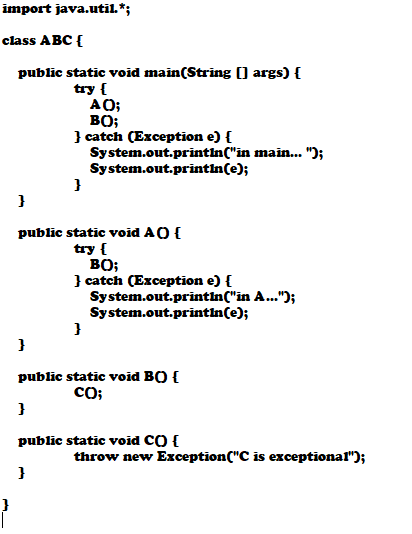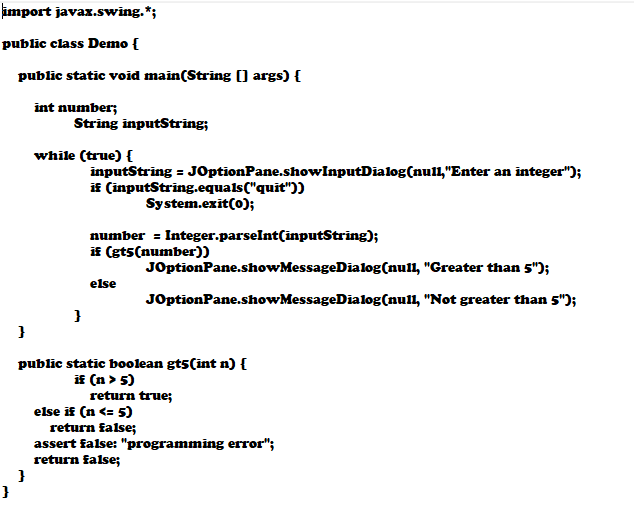Question
Exceptions and Assertions Download program files (Lab08.zip). Propagating Exceptions: Go into subdirectory ABC and edit the ABC class. Examine the code and predict what will
Exceptions and Assertions
Download program files (Lab08.zip).
Propagating Exceptions:
Go into subdirectory ABC and edit the ABC class. Examine the code and predict what will happen if you compile this program.
Compile the program and examine the compiler error messages. What is the problem with this code?
- Call us over when you are ready to answer the question.
Add a throws Exception modifier to the declaration of the method C(). Predict what will happen when you compile your program with this change.
Compile the program and examine the results. Does your code continue to have problems?
- Call us over when you are ready to answer the question.
Add a throws Exception modifier to the declaration of the method B(). Predict what will happen when you compile your program with this change.
Compile the program and examine the results. Does your code continue to have problems?
- Call us over when you are ready to answer the question.
Predict what will be output when you compile and run your program with the change described above. Run the program and be prepared to explain your results.
In your code for main, add a call to method C() immediately after the calls to methods A() and B() in the try part of the try-catch block. Predict what will be output when you compile and run your program with this change. Run the program and be prepared to explain your results.
Change method B() so that it catches any exception thrown by the call to method C(). When B() catches an exception, it should throw a new exception that it constructs with the text "B is even more exceptional."
Make this change to your code and predict what will happen when you compile and run your program. Compile and run it and examine your results.
- Finally, in your ABC class modify the C() method by removing the throw statement, replacing it with the statement System.out.println("in C..."). Predict what will happen when you run your modified program.
Compile and run your modified program and examine your results.
Assertions:
Go into the directory GT5 and edit the class Demo.
Study the code for the method gt5() (which stands for greater than 5). The intended purpose of this method is to return true if it is passed a value greater than 5 and false otherwise. The assert near the end of this method should never be executed (why?).
Normally, an assert will behave like an exception, immediately terminating the procedure. Why is there a final return statement after the assert?
Why does the assert statement have false as the assert condition?
Compile and run this program with a number of different integer input values, and observe the behavior of your program. Enter "quit" to terminate the program. Can you find an integer input value that triggers the assert statement?
- Change the else if statement in the gt5() method so that the condition is (n
Compile and run your program. Can you find an integer input value that triggers the assert statement? If so, how does your program behave with this input value?

Step by Step Solution
There are 3 Steps involved in it
Step: 1

Get Instant Access to Expert-Tailored Solutions
See step-by-step solutions with expert insights and AI powered tools for academic success
Step: 2

Step: 3

Ace Your Homework with AI
Get the answers you need in no time with our AI-driven, step-by-step assistance
Get Started


